AMD Ryzen Threadripper 7980X & 7970X Review: Revived HEDT Brings More Cores of Zen 4
by Gavin Bonshor on November 20, 2023 9:00 AM EST- Posted in
- CPUs
- AMD
- HEDT
- ThreadRipper
- Zen 4
- Threadripper 7000
- TRX50
TR 7000 vs. Intel: Power and Compile
Our previous sets of ‘office’ benchmarks have often been a mix of science and synthetics, so this time, we wanted to keep our office and productivity section purely based on real-world performance. We've also incorporated our power testing into this section. Given the nature and target market of the Ryzen Threadripper 7000 series, we've opted to focus on tasks such as compiling.
We are using DDR5-5200 RDIMM memory on the Ryzen Threadripper 7980X and 7970X as per JEDEC specifications. For Intel's Xeon W9-3495X, we are using DDR5-4800 RDIMM memory as per Intel's JEDEC specifications. It should be noted that both platforms are run with their full allocation of memory channels, e.g., TR7000 in 4-channel and Sapphire Rapids in 8-channel.
Below are the settings we have used for each platform:
- DDR5-5200 RDIMM - AMD Threadripper 7000
- DDR5-4800 RDIMM - Intel Xeon Sapphire Rapids WS
- DDR5-5600B CL46 - Intel 14th Gen
- DDR5-5200 CL44 - Ryzen 7000
Power
The nature of reporting processor power consumption has become, in part, a bit of a nightmare. Historically the peak power consumption of a processor, as purchased, is given by its Thermal Design Power (TDP, or PL1). For many markets, such as embedded processors, that value of TDP still signifies the peak power consumption. For the processors we test at AnandTech, either desktop, notebook, or enterprise, this is not always the case.
Modern high-performance processors implement a feature called Turbo. This allows, usually for a limited time, a processor to go beyond its rated frequency. Exactly how far the processor goes depends on a few factors, such as the Turbo Power Limit (PL2), whether the peak frequency is hard coded, the thermals, and the power delivery. Turbo can sometimes be very aggressive, allowing power values 2.5x above the rated TDP.
AMD and Intel have different definitions for TDP that are, broadly speaking, applied the same. The difference comes from turbo modes, turbo limits, turbo budgets, and how the processors manage that power balance. These topics are 10000-12000 word articles in their own right, and we’ve got a few articles worth reading on the topic.
- Why Intel Processors Draw More Power Than Expected: TDP and Turbo Explained
- Talking TDP, Turbo and Overclocking: An Interview with Intel Fellow Guy Therien
- Reaching for Turbo: Aligning Perception with AMD’s Frequency Metrics
- Intel’s TDP Shenanigans Hurts Everyone
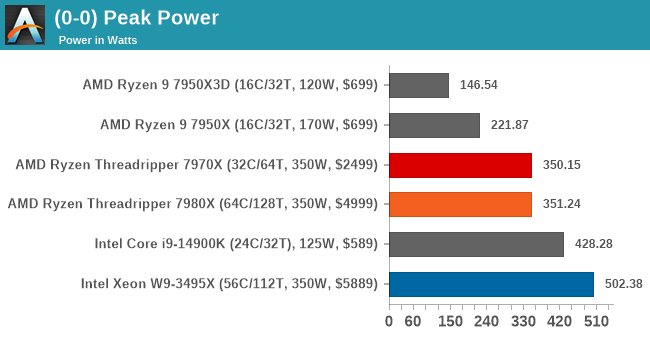
Looking at the max power we observed on the AMD Ryzen Threadripper 7980X and 7970X processors, we can see they hit and don't go robustly above their rated TDPs of 350 W. In contrast, the Intel Xeon W9-3495X peaked at a huge 502 W, well above the rated 350 W TDP. Compared to the desktop processors we've added to the data set, both Threadripper 7000 series processors are also considerably below the Intel Core i9-14900K.
Moving onto a deeper look at how the AMD Ryzen Threadripper 7980X compares to the Intel Xeon W9-3495X in Prime95 with Small FFTs, we can see that Intel's Sapphire Rapids WS option draws considerably more power. Despite having eight more cores than the W9-3495X, the Threadripper 7980X runs consistently within AMD's designated TDP of 350W; this is the TDP for all three AMD Ryzen Threadripper 7000 series SKUs. As we've highlighted in our desktop reviews of the Ryzen 9 7950X and Ryzen 9 7950X3D processors, we know AMD's Zen 4 core doesn't only deliver in performance, but it's a highly efficient core, too.
Compile/Database
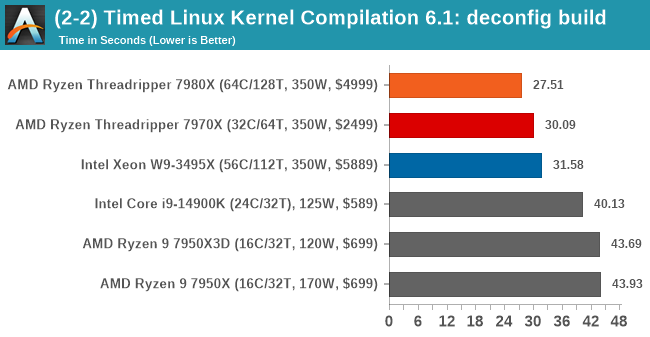
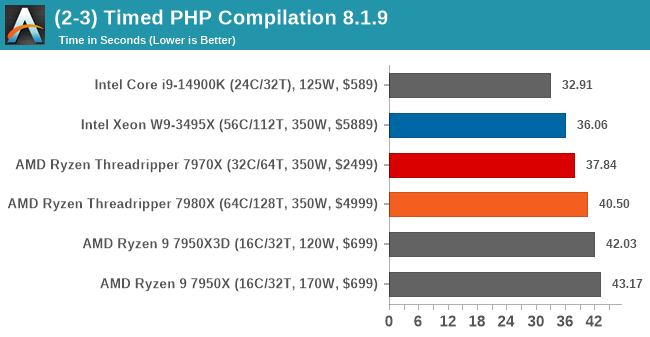
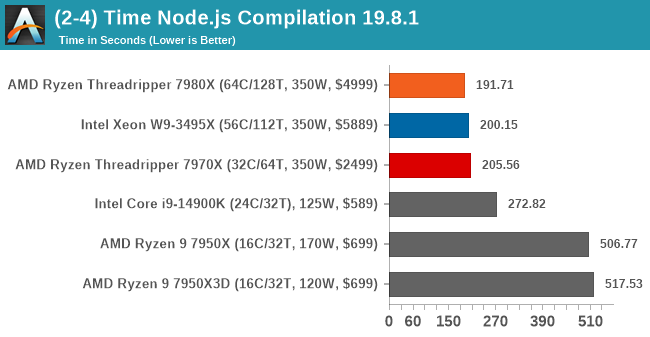
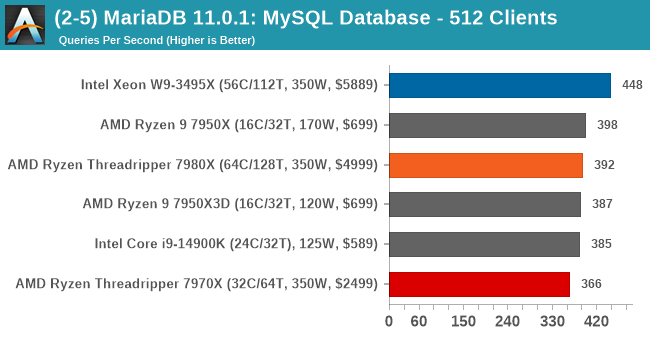
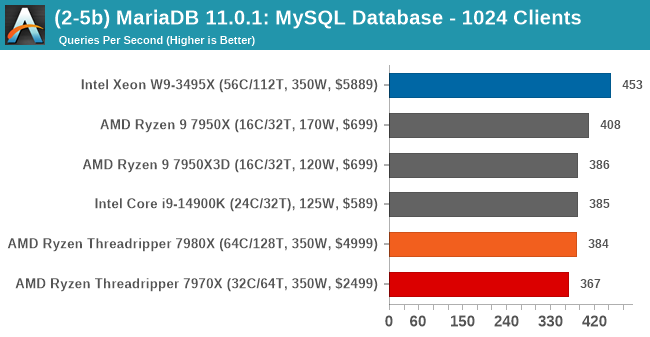
In our timed compilation benchmarks, including Linux Kernel, PHP, and Node.js, we can see that the Threadripper 7980X and 7970X perform well for the most part. In larger compilations such as Node.js, there's a significant advantage to having a higher core/thread count. Intel's Xeon W9-3495X beats all the chips we tested convincingly in the MariaDB MySQL database benchmark, with the flagship desktop chips also performing well here.


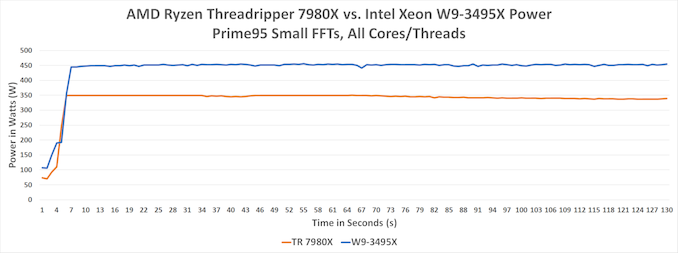








66 Comments
View All Comments
tamalero - Tuesday, December 5, 2023 - link
One of the most common issues of AMD is sketchy performance and stability with non samsung chips.If you ram had hynix or similar chips..it would usually not post at the advertised max speed.
As soon I moved to Samsung chips in all my AMD builds, all problems went away.
JRF68 - Tuesday, December 12, 2023 - link
Just unlucky. Should RMA the mb. Asus imho, is still the best for HEDT whether AMD or Intel.clsmithj - Sunday, December 31, 2023 - link
I have a 3960X Threadripper on a MSI TRX40 Creator, and a 2990WX Threadripper on a MSI X399 MEG Creation board.Both system use 4 sticks of Kingston 64GB (16GB x 4) DDR4 3200 dual rank memory (HyperX Predaor/Fury) that worked fine at their C16 3200 MT XMP rate.
I used DRAM Calc app and managed to get the RAM of my 3960X to run stable at gear 1 C16 3800 MT with UCLK=MCLK set 1900Mhz.
The ZEN2 CPU is definitely capable of this high memory OC. I've watch Buildzoid clips of him showing how with ZEN2 TR it can go even higher than 3800.
My ZEN+ 2990WX I have running at Gear 1 C16 DDR4-3466 speed, and I checked ZenTimings that revealed its UCLK=MCLK is at 1733Mhz.
The high memory clocking is doable you do need a good motherboard, but I always observed the TRX40 boards having a fast amount of decent boards with high amount of VRM phases.
It was the X399 boards that only had a total of two good boards, which was either the MSI MEG Creation or the ASUS ROG Zenith Extreme.
thestryker - Monday, November 20, 2023 - link
Where have you seen JEDEC compliant 6400 RDIMMs? The highest I've seen is 5600.Rοb - Wednesday, November 29, 2023 - link
Here: https://www.anandtech.com/show/18988/teamgroup-unv... and https://www.anandtech.com/show/21129/micron-introd...demu - Monday, November 20, 2023 - link
I was able to run my 3960X with G.Skill Trident Neo 4x16GB 3600CL16 (B-die) at 3600CL14 and/or 3766 CL16 (Asus ROG Strix TRX40-E Gaming) for weeks without any problems.Broke down the processor about two months ago. Touched accidentally USB-A -port with an USB-C -cable and the processor no longer booted (or booted and went trough all but the last POST test and then stuck - tried two different MB) :(
Put all components into a new 5800X3D system and got 4x16GB memory to work @3600CL16.
Now considering the new 7960X.
Makaveli - Monday, November 20, 2023 - link
So looks like the difference between your system Demu and Teamswitcher is you paired it with high-quality memory.Which is no surprise and it's why I never go cheap on memory.
meacupla - Monday, November 20, 2023 - link
It's not about cheap or expensive, it's if you got Samsung B-die or not.I have G.Skill F4-3600C18-16GVK, and it only works at 3200 CL18. Why? because I was told it would be Samsung B-die, but it turned out to be SK Hynix, and the AM4 platform doesn't like working with anything other than Samsung B-die.
Makaveli - Monday, November 20, 2023 - link
I have B-die and that is what I'm talking about when I said don't buy cheap memory. B-die = expensive but you get what you pay for and it just works. And you should have done your own research I would have caught the memory was Hynix before purchase.meacupla - Monday, November 20, 2023 - link
That's the thing though, I did do my research.